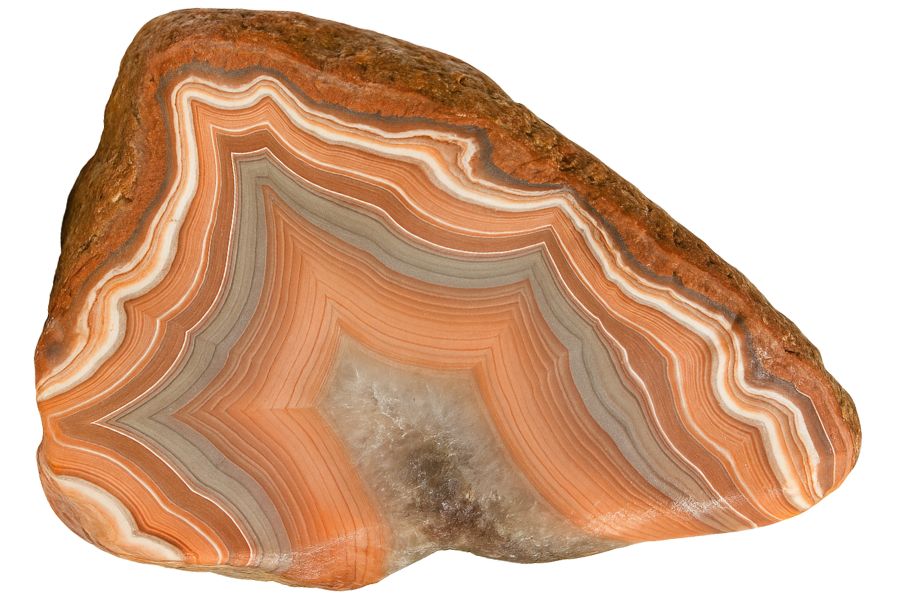Next time you head outdoors, look closely at the gravel for beautiful Indiana agates. These valuable stones are a type of quartz known for stunning inner layers of color, and they were carried down to the region by massive ancient glaciers.
The exposed gravel beds along the Ohio River are excellent to search, as the powerful currents polish the stones smooth, making them easier to identify. You can also explore inland creeks and streams after heavy rain for fresh finds.
Finding these unique pieces requires more than just good luck. To successfully collect the best agates in the state, developing an eye for their specific waxy texture and translucent quality is key.
Learning the right spots and getting clear local insight will help people find agates in the state!
What is Indiana Agate?
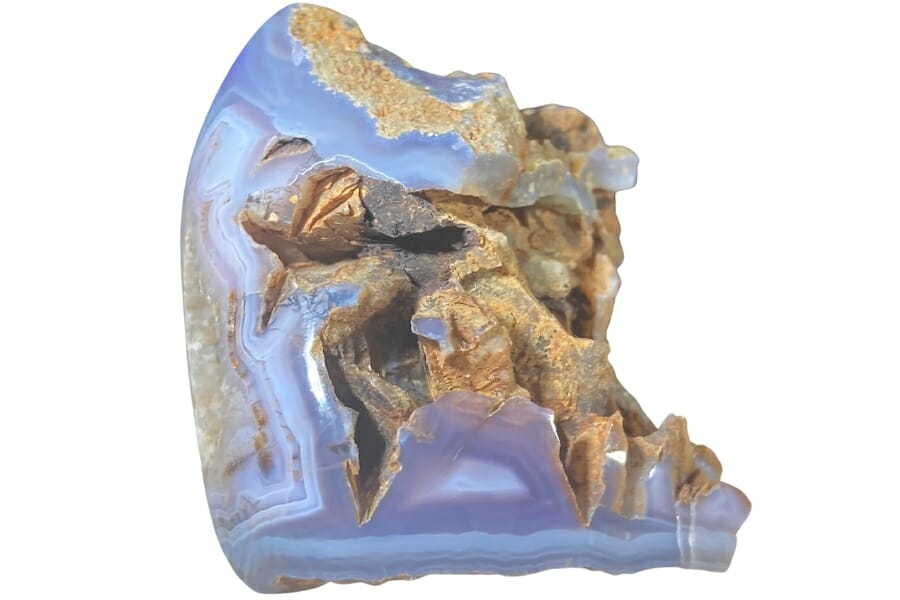
Agate is a type of mineral, specifically a form of quartz, known for its remarkable beauty and captivating patterns. What sets it apart are its mesmerizing bands and swirls of colors and textures. These patterns are formed as mineral-rich waters slowly fill cavities in rocks over time, layer by layer.
The value and price of agates can vary widely depending on many factors, and you can check out our article on that. Some agates are cherished for their rarity and exquisite beauty, commanding high prices from collectors and jewelry enthusiasts.
When it comes to where you can uncover these precious gems, agates can be found in various places around the globe. They’re commonly discovered in volcanic rocks like basalt and also in sedimentary rocks.
Now, before we share with you the verified spots where you can find Indiana agates, let’s first discuss the different types of agates and whether you can find them here:
Blue Lace Agate
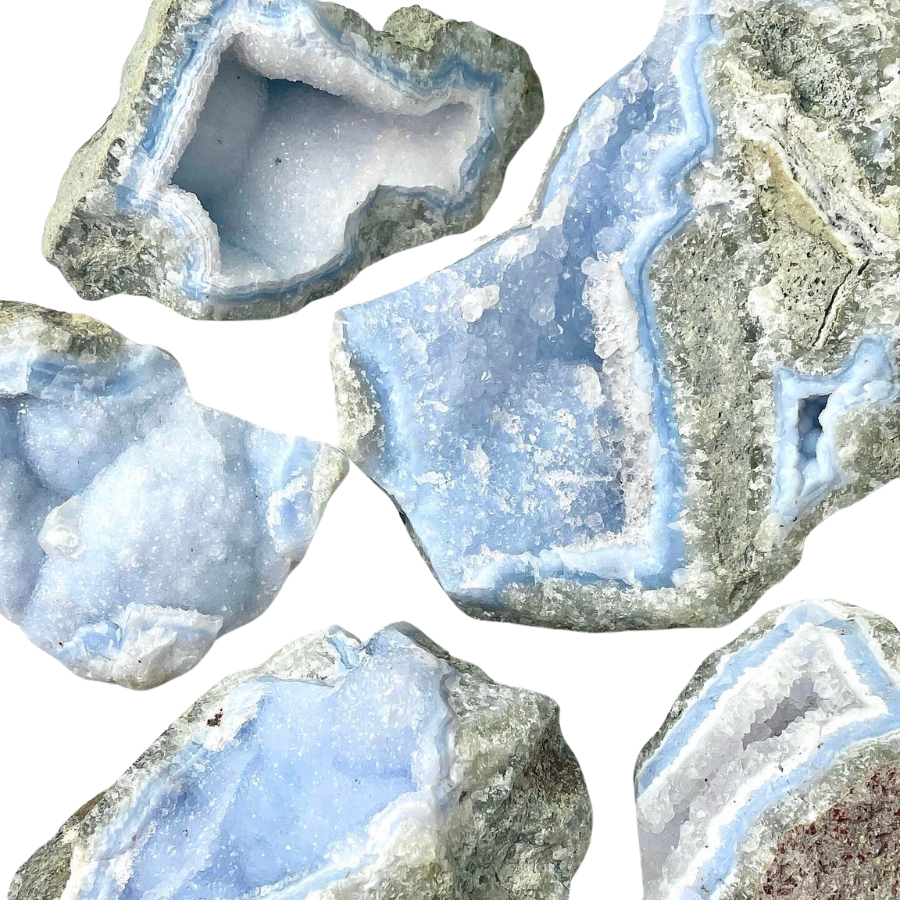
Blue lace agate is like the soft, sky-blue waves with lines that swirl and twist like delicate lace.
Its pattern comes from slow-forming layers of quartz, which create those beautiful, lace-like bands.
The bands of this agate type are often in shades of light blue, white, and sometimes a bit of grey. It’s different from other agates, which usually have more intense colors and stronger patterns.
The value of blue lace agate lies in its soft, tranquil look and the feeling of calm it brings. It’s often used in jewelry or as a decorative stone.
If you want REAL results finding incredible rocks and minerals you need one of these 👇👇👇
Finding the coolest rocks in isn’t luck, it's knowing what to look for. Thousands of your fellow rock hunters are already carrying Rock Chasing field guides. Maybe it's time you joined the community.
Lightweight, mud-proof, and packed with clear photos, it’s become the go-to tool for anyone interested discovering what’s hidden under our red dirt and what they've already found.
Join them, and make your next rockhounding trip actually pay off.
What makes it different:
- 📍 Find and identify 140 incredible crystals, rocks, gemstones, minerals, and geodes across the USA
- 🚙 Field-tested across America's rivers, ranchlands, mountains, and roadcuts
- 📘 Heavy duty laminated pages resist dust, sweat, and water
- 🧠 Zero fluff — just clear visuals and straight-to-the-point info
- ⭐ Rated 4.8★ by real collectors who actually use it in the field
Moss Agate

Instead of having the typical banding for which the different types of agates are known, moss agate has green inclusions that look like moss or trees.
These green patterns aren’t real plant material, though. They’re minerals like chlorite or iron oxide.
In some cultures, this type of agate is known as the “gardener’s stone” because of its green, plant-like appearance. It’s believed to help plants grow.
The price of moss agate can vary. It’s often quite affordable, but the more distinct and picturesque the green patterns, the more it might cost.
Fire Agate
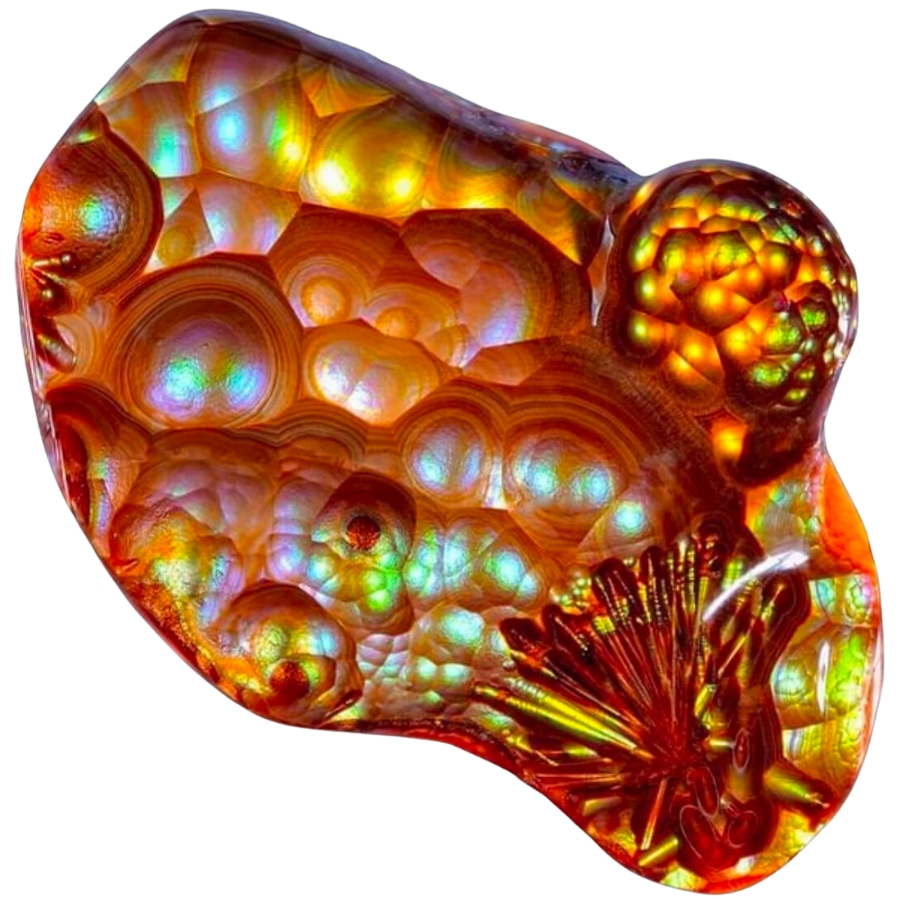
Fire agate is known for its incredible colors and the way it sparkles like fire. It’s got layers of silica and iron oxide that reflect light, creating a fiery effect.
When you look at fire agate, it’s like seeing flames trapped inside. Its colors can range from reds and oranges to greens and golds, all shimmering under the surface.
You might be wondering, “What is fire agate worth?” Well, its value comes from its rare beauty. The more color and sparkle, the more valuable the stone is.
Its fiery iridescence and lively play of color are used in jewelry pieces that are meant to stand out.
Dendritic Agate
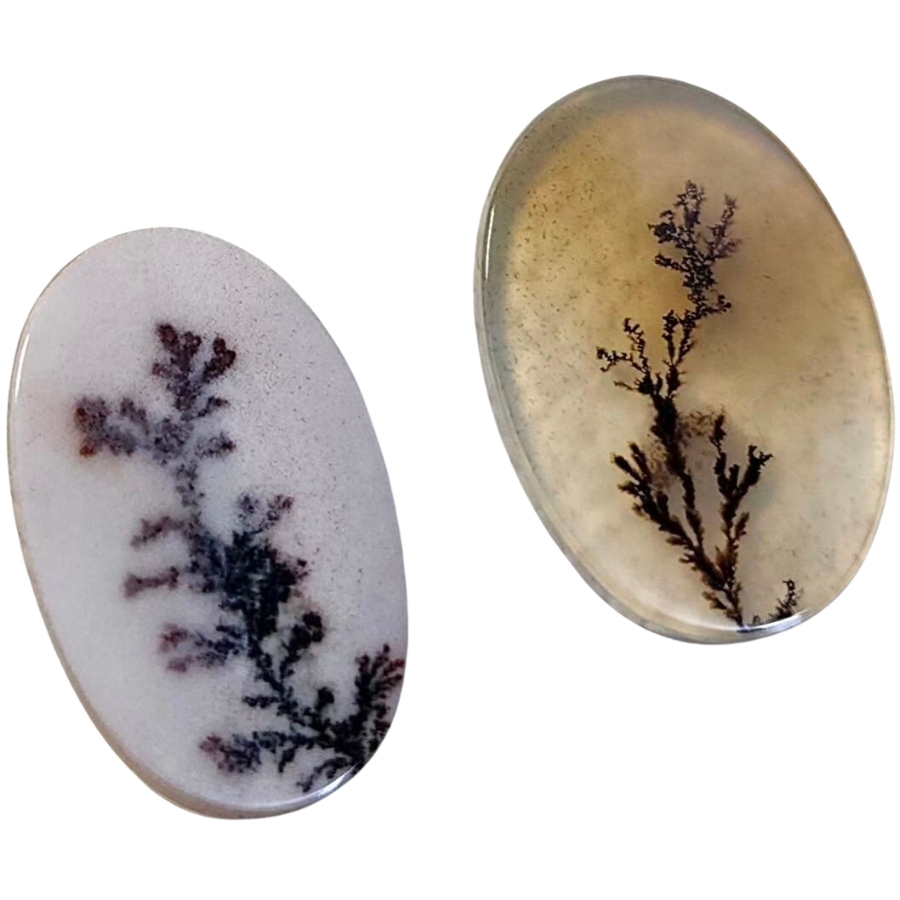
Dendritic agate is known for patterns that look like tiny trees or shrubs. Like moss agate, these patterns aren’t actual plants. They’re made of minerals, mostly manganese or iron oxides.
When you look at a dendritic agate, it’s like peering into a miniature forest or a frosty winter landscape.
The base of the stone is usually translucent to opaque, and the “dendrites”— those tree-like patterns— are often black or brown.
When it comes to how much dendritic agate is worth, it can vary. The more detailed and distinct the patterns are, the more it’s usually valued.
In some cultures, dendritic agate is believed to bring fullness and richness to life.
Crazy Lace Agate
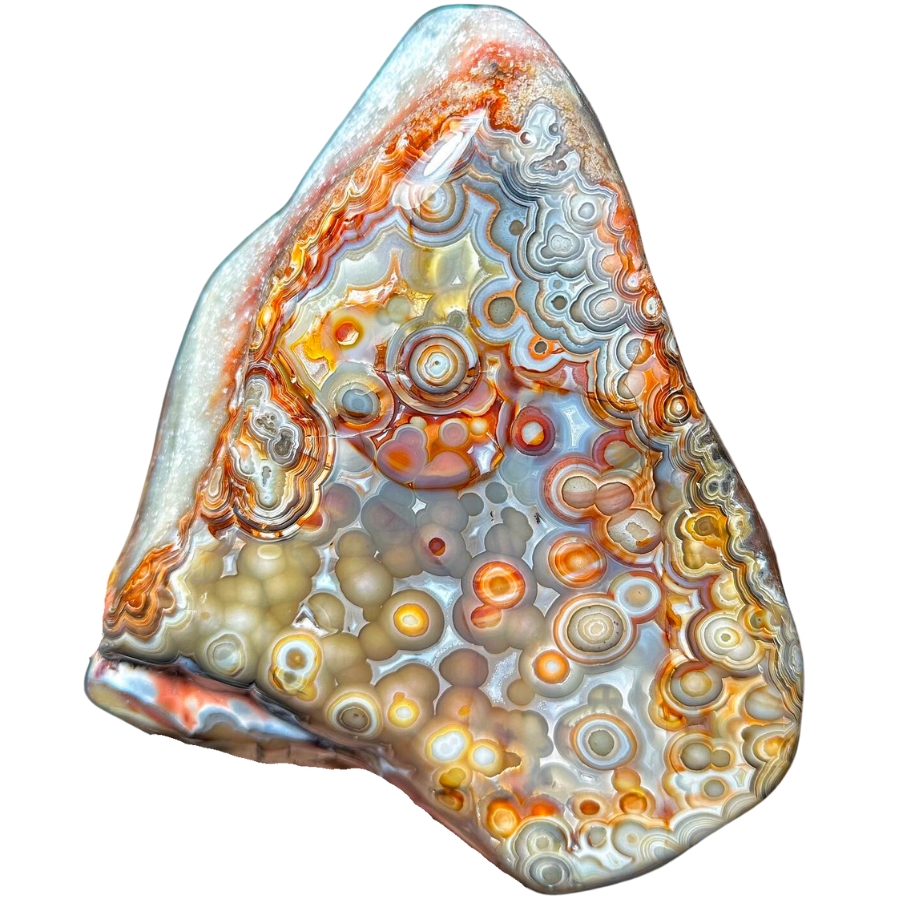
Crazy lace agate is like a party in a rock! It’s got swirls, circles, and all sorts of wild patterns dancing across it.
Its colors can be a mix of red, orange, yellow, and brown, and sometimes even a bit of gray or white.
What makes crazy lace agate stand out is its vibrant and complex patterns. No two pieces are the same. This distinctiveness is a big reason why it’s so valued.
Despite its wild and ‘crazy’ appearance, it’s sometimes called the “Laughter Stone” or “Happy Lace” because of the joy and positive vibes it’s believed to bring.
Laguna Agate
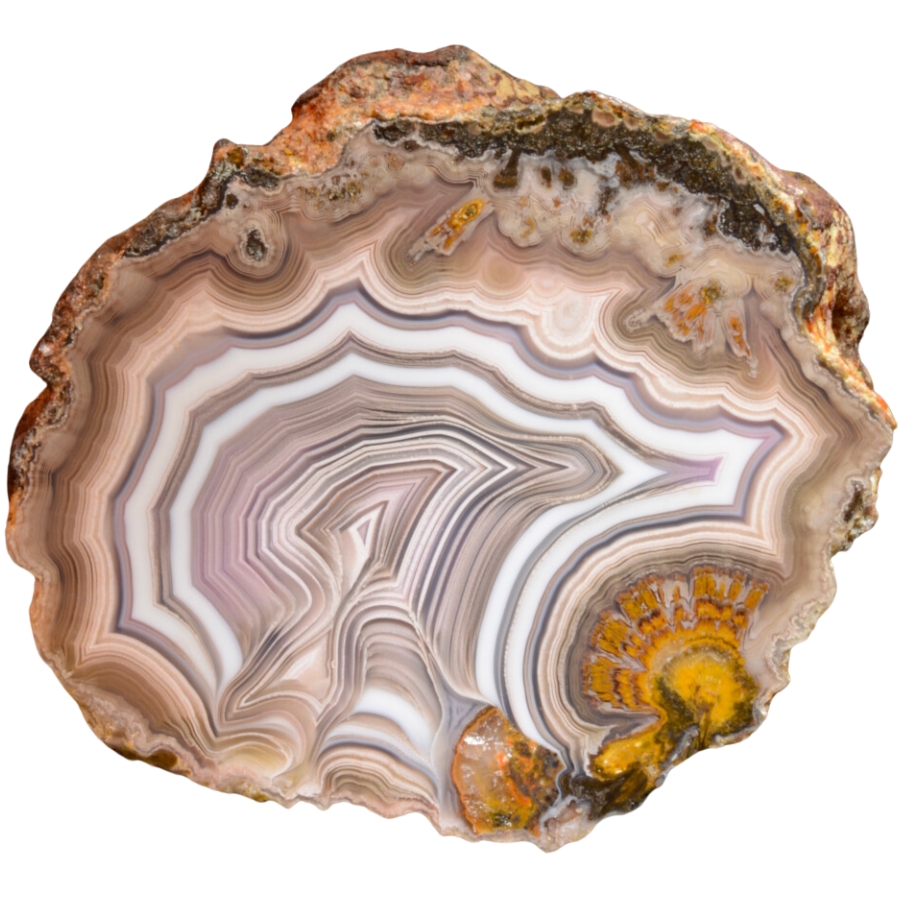
Laguna agate has incredibly sharp and fine banding. It has layers of red, orange, pink, yellow, and sometimes even purple and white all stacked in neat, tight bands.
These bands can form eye-catching patterns, like swirls, loops, and even landscapes.
The different colors of its bands come from various minerals present in the water at the time of its formation.
Laguna agate is considered one of the finest agates in the world due to its exceptional banding. This high regard among agate varieties makes it a prized possession for collectors.
Condor Agate
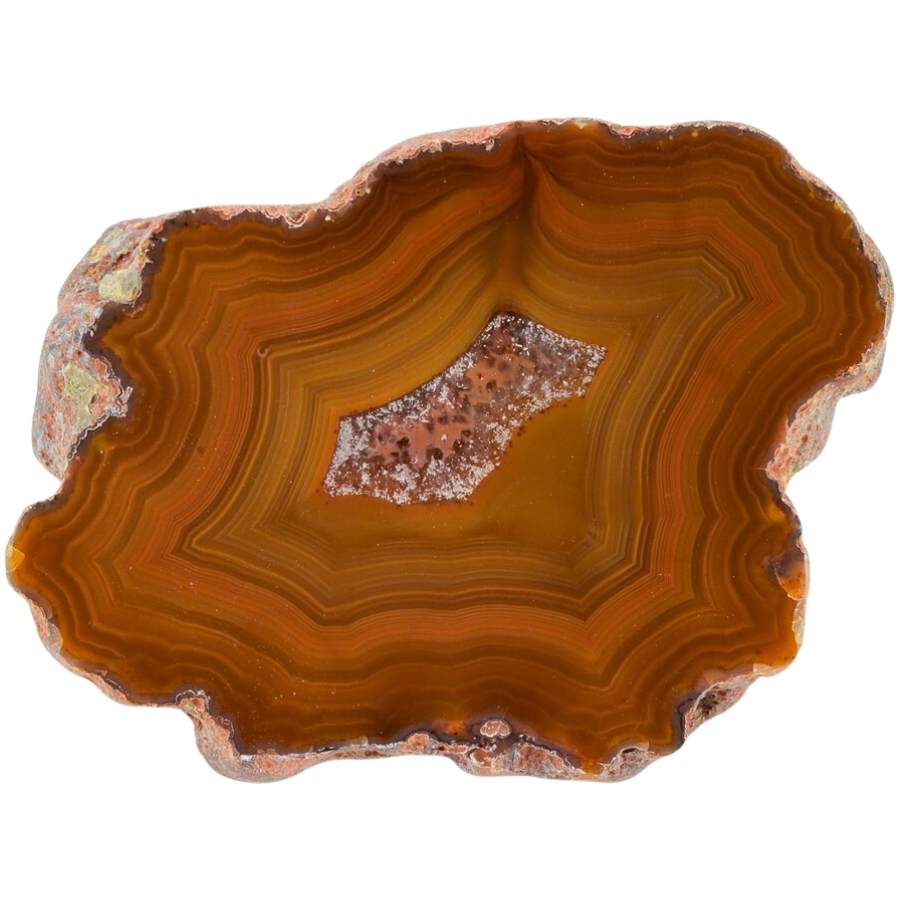
Condor agate is a real standout. It’s known for its bright, vivid colors and complex patterns.
It has reds, oranges, yellows, and sometimes even blues and greens all swirling together. These colors form in bands or in more random, artistic patterns.
The intensity and variety of its colors is what makes condor agate so special. It’s often used by artists and craftsmen who want to make a statement with their work.
Condor agate’s bold colors and patterns can turn a simple piece of jewelry or art into something really eye-catching.
Fortification Agate (Banded Agate)
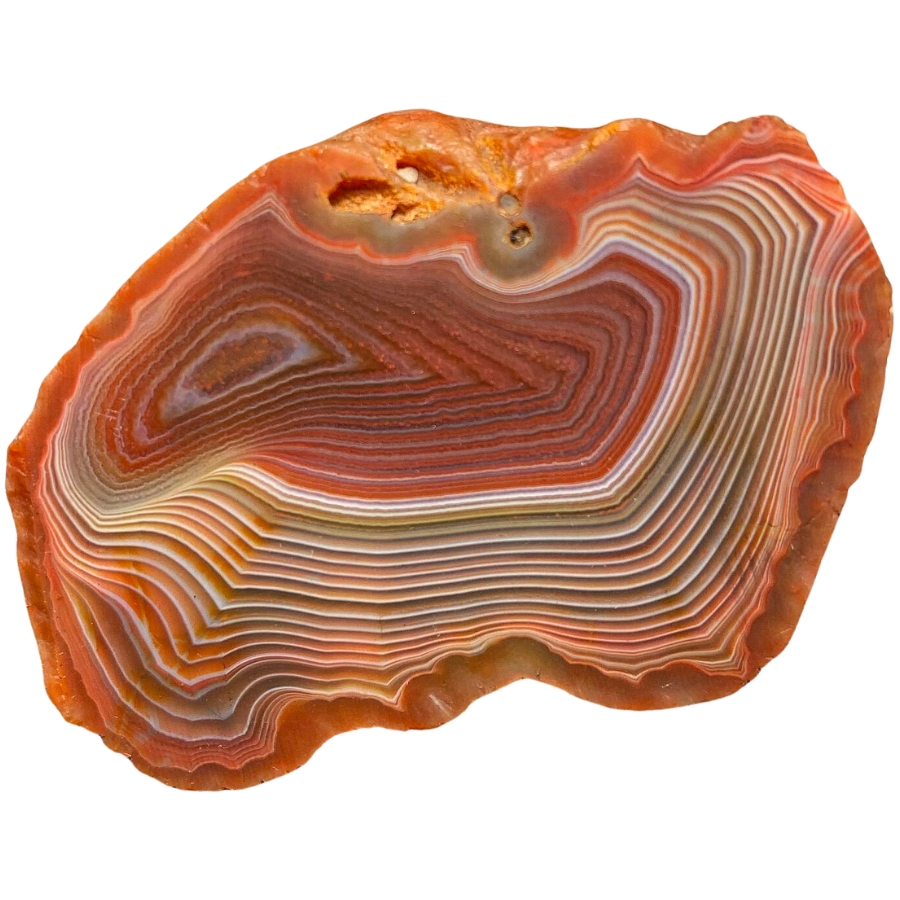
Fortification agate gets its name because the patterns inside it look like the aerial view of a fortified city.
Imagine seeing bands of color forming shapes that look like walls, with sharp angles and curves. They are usually in different colors, making each layer stand out.
If fortification agate is valuable, it’s because of its distinct patterns and colors. Its unique look makes it sought after for jewelry and as a collector’s item.
The clearer and more defined the patterns, the more valuable the stone can be. Some people also believe it can help with relaxation and calmness.
Iris Agate
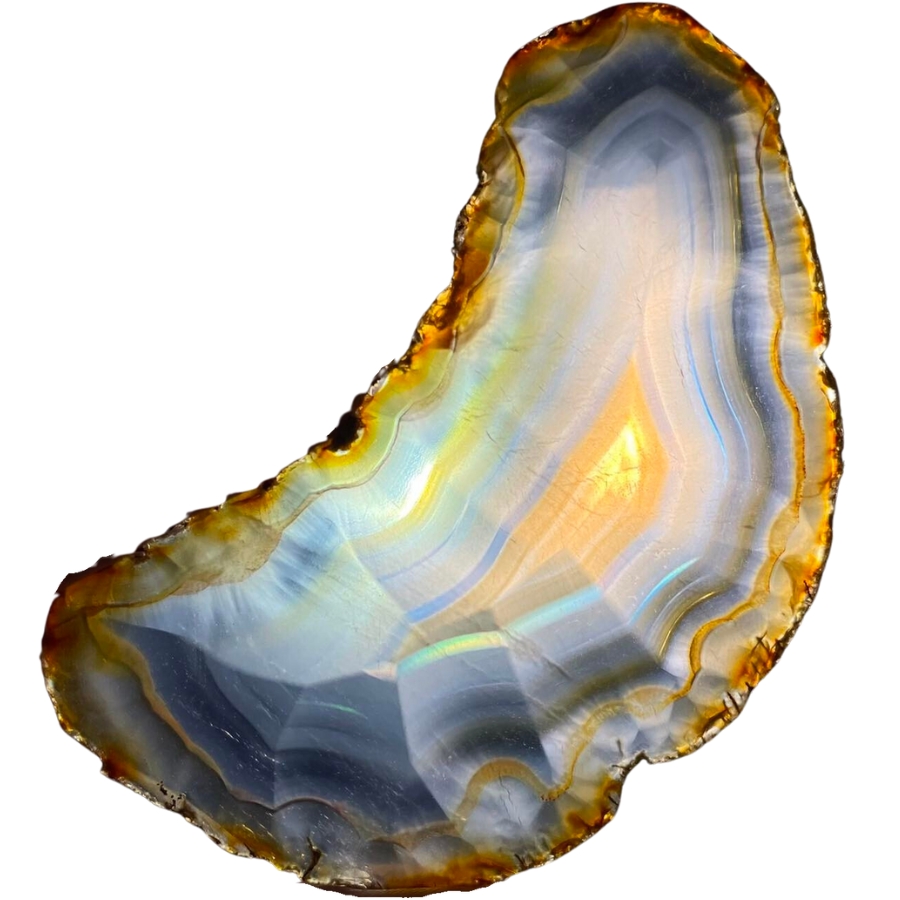
Iris agate looks like a regular agate at first, but when you hold it up to the light, something amazing happens. It shows all these rainbow colors, like light passing through a prism.
This is because it has very thin layers of silica, and when light hits these layers, it splits into all the colors of the rainbow.
The formation of iris agate is similar to other agates, but its layers are super thin, which is what creates the rainbow effect.
The value of iris agate comes from its unique ability to show these colors. In the past, people even used to think it had magical properties because of the way it showed colors. They saw it as a stone of good luck and wonder.
Plume Agate

Plume agate gets its name from its patterns that look like soft, feathery plumes. These plumes can be in all sorts of colors: red, black, green, or yellow, set against a translucent or opaque background.
The way these plumes seem to float in the stone makes it look like a frozen underwater scene or like feathers caught in a breeze.
The plumes are made of minerals like manganese or iron oxide, which get trapped in the silica during the agate’s formation and create the feathery patterns.
The price of plume agate can vary depending on how clear and intricate the patterns are. The more detailed and colorful the plumes, the more the stone is usually worth.
Picture Agate (Scenic Agate)
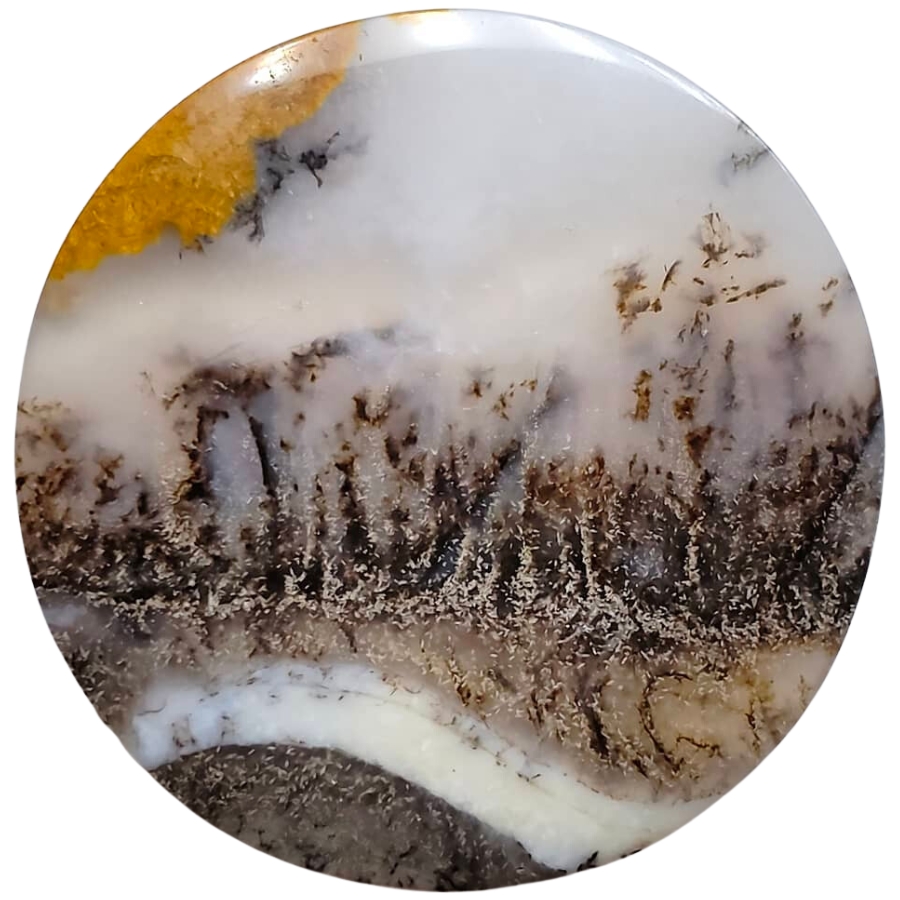
Picture agate is like a snapshot of nature captured in stone because it looks like it has pictures or scenes right inside it.
These “pictures” are actually natural patterns that resemble landscapes, mountains, trees, or even skies. They are usually in different shades of brown, white, and gray against a more translucent background.
The different patterns in picture agate or what’s also called scenic agate are made by various minerals in the water filled with silica that forms it.
If you’re thinking, “What is picture agate worth?“, its value comes from how distinct, clear, and detailed the natural “pictures” are.
Turritella Agate

Turritella agate is not your typical agate because it’s full of fossilized snail shells! The shells belong to a creature called Turritella, a type of sea snail.
These shells are tightly packed and create a pattern that looks like a bunch of tiny, swirling towers. The background of the agate is usually a dark, earthy color, which makes the white or cream-colored snail shells really pop.
Over millions of years, these snail shells got buried in sediment and eventually became fossilized. As time went on, silica-rich water flowed through the sediment, turning it into the agate we see today.
The value of turritella agate comes from its unique blend of geology and history. More than a pretty stone, it’s a piece of ancient life preserved in rock.
Fairburn Agate
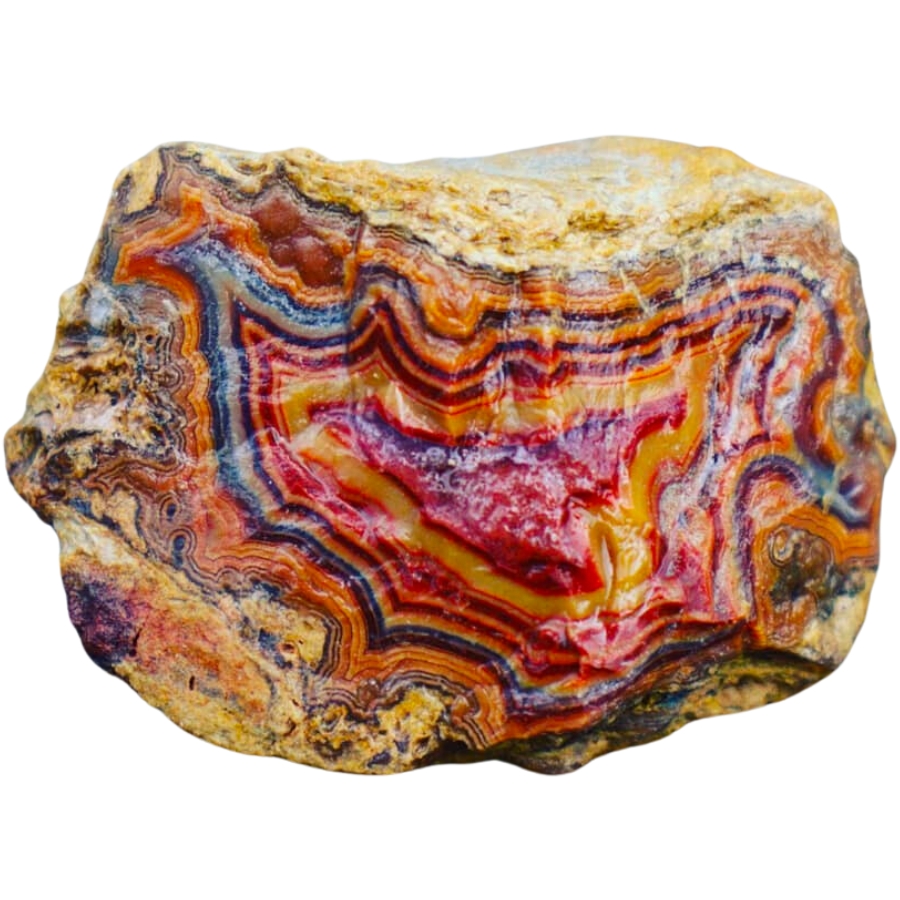
Known for its intricate patterns and bold colors, Fairburn agate is another fascinating type of agate. It usually has bands and swirls of different colors like red, yellow, orange, brown, and sometimes even pink or purple.
What’s special about these patterns is they often look like they’re in layers, creating a 3D effect. It’s like looking at a landscape made of stone.
It’s named after a place called Fairburn in South Dakota. This gives a clue about where it was first discovered.
People value Fairburn agate for the skill it takes to cut and polish it, which makes the patterns and colors really stand out.
Sagenite Agate
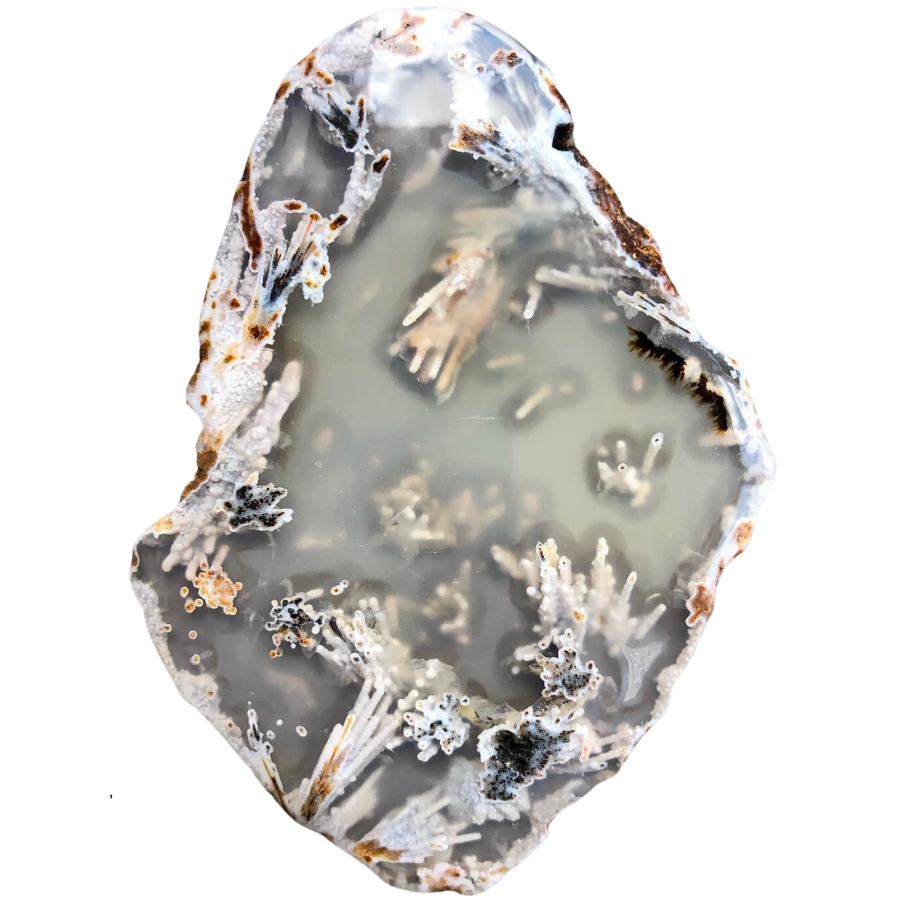
Sagenite agate has needle-like inclusions that look like tiny sprays of crystals inside it. They can be gold, silver, black, or even green, and they spread out in all directions, creating an amazing pattern.
The base of the agate is usually translucent, which lets you see these intricate needle patterns clearly.
These patterns are actually other minerals, like rutile or goethite, that get trapped inside the forming agate. These minerals grow in a crystal shape, looking like needles or hair.
Sagenite agate is often used in jewelry and other decorative items, with some people thinking that its needle patterns look like fireworks or starbursts.
Tree Agate
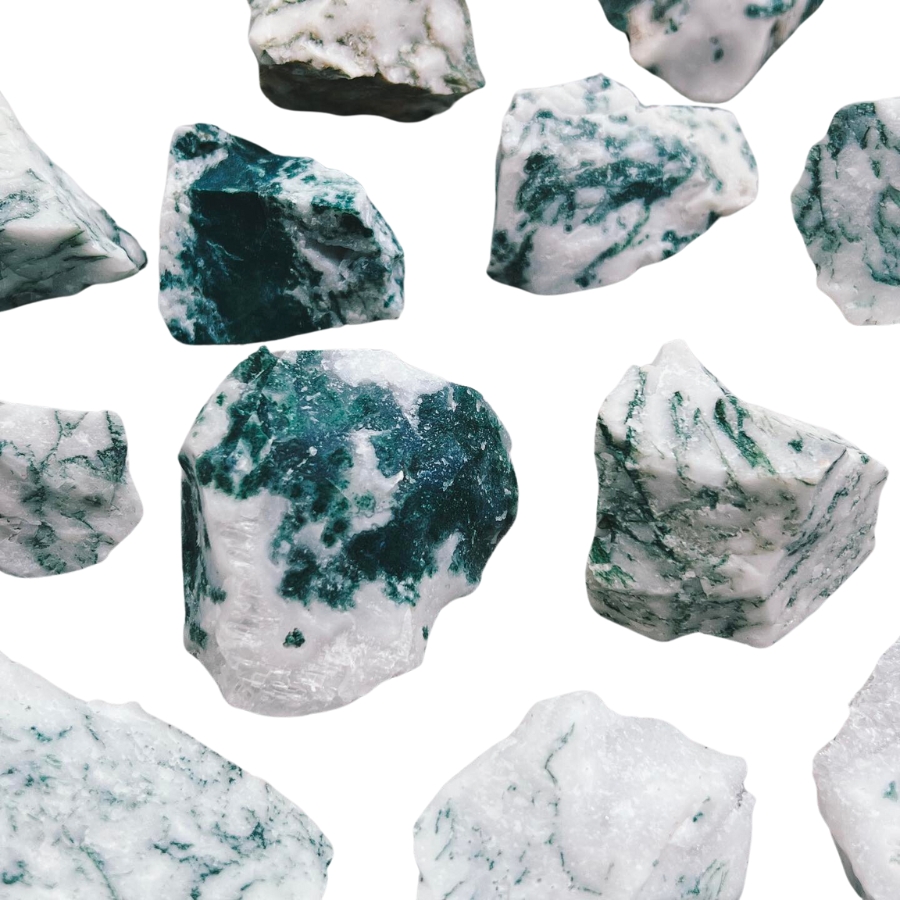
Tree agate, as its name suggests, looks like it’s got tiny trees or branches inside it. These tree-like patterns are usually green and spread out against a white or light gray background.
The green patterns aren’t actual trees, though. They’re made of minerals like chlorite or manganese.
Each piece of tree agate is different. You won’t find two that are exactly the same. It’s valued for its looks and it’s often used in jewelry and decorations.
The key factors in our recommendations are:
- The deep experience and understanding of our team about the area
- Recommendations from local groups and clubs
- How easy it is to get the a particular location
- Safety and potential hazards when collecting
- Weighing private and public locations
- The ability for both experienced and novice agate enthusiasts to find great samples
With these factors in mind we’ve been able to put together a fantastic list that just about anyone can use!
Kids. Beginners. Pros. Doesn’t matter. This book has become the go-to because it works for everyone.
Magy put it bluntly: “Identify rocks, crystals and minerals is so easy now!”
That’s not by accident, the photos are crisp, the callouts are simple, and the design is rugged enough to throw in a backpack without worrying. Whether it’s your first geode or your hundredth, this guide keeps the fun part simple: finding more treasures.
The Best Spots To Find Agates in Indiana
Indiana has many great gem mine sites, but if you need guidance that’s focused on finding agates, below are the verified spots that you can explore:
Always Confirm Access and Collection Rules!
Before heading out to any of the locations on our list you need to confirm access requirements and collection rules for both public and private locations directly with the location. We haven’t personally verified every location and the access requirements and collection rules often change without notice.
Many of the locations we mention will not allow collecting but are still great places for those who love to find beautiful rocks and minerals in the wild without keeping them. We also can’t guarantee you will find anything in these locations since they are constantly changing.
Always get updated information directly from the source ahead of time to ensure responsible rockhounding. If you want even more current options it’s always a good idea to contact local rock and mineral clubs and groups
Maumee River
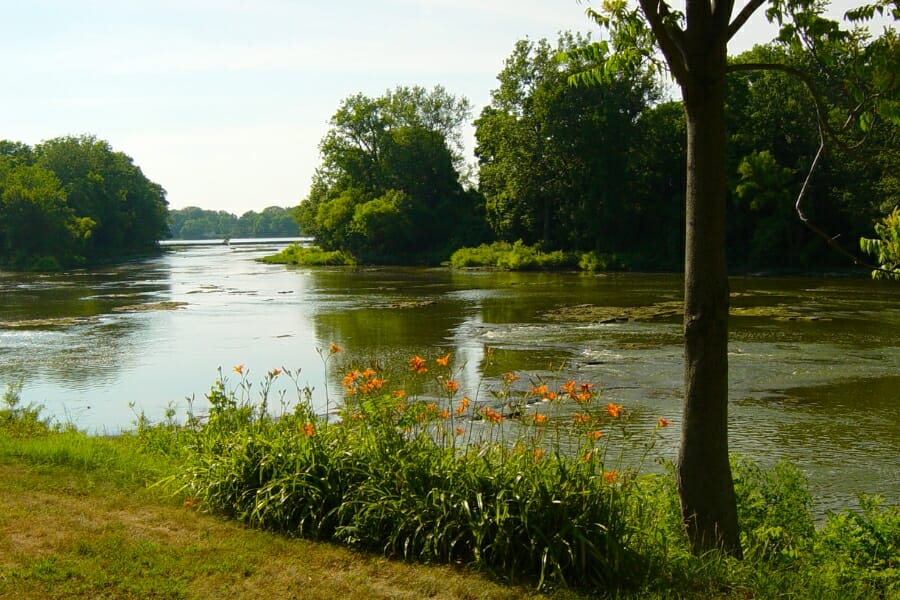
Maumee River, which stretches for over 100 miles through the northwestern part of our state, offers a unique opportunity to discover beautiful agates.
This region is characterized by gently rolling hills, fertile farmland, and lush forests. The river itself winds its way through this picturesque landscape, and its terrain varies from rocky outcrops to sandy shores.
From a geological perspective, the Maumee River area features a mix of sedimentary and glacial deposits. These geological conditions can occasionally yield agates, particularly along the riverbanks and in gravel bars.
Getting here is relatively easy, thanks to its accessibility via highways and local roads. You’ll find various access points along its course, including parks, public lands, and bridges. Just remember to check Indiana’s local collecting guidelines for rockhounding activities.
Where we found agates in the Maumee River
You can find agates in the gravels and downstream along the Maumee River to the Ohio state line.
May Stone and Sand Quarry
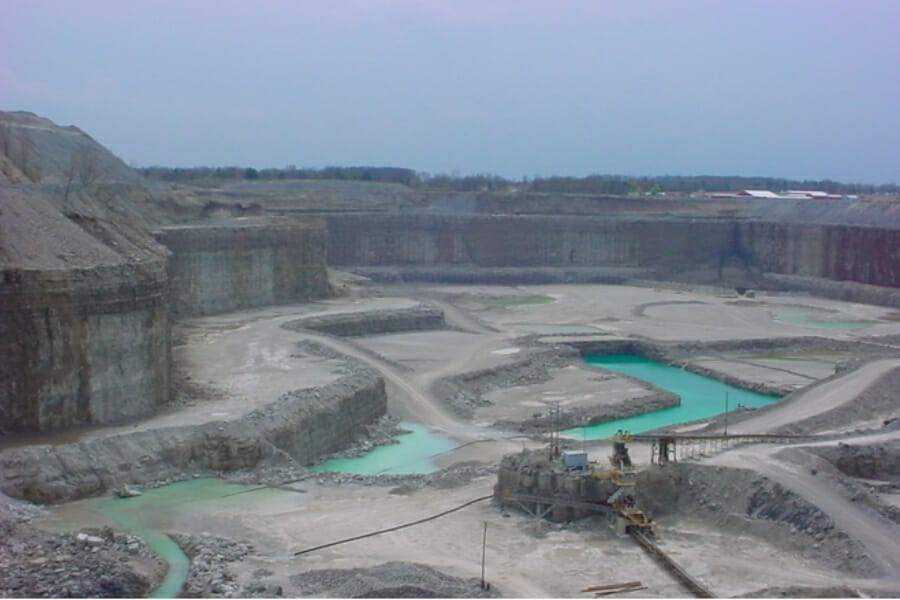
Situated in the north-central part of Indiana, May Stone and Sand Quarry offers a fascinating glimpse into the geological history of our region and the potential to find agates.
Geographically, it’s located in an area characterized by rolling hills and fertile farmland. The terrain within the quarry itself is a mix of exposed rock faces, gravel pits, and sandy areas. This diversity in terrain makes it an intriguing location for rockhounding adventures.
From a geological perspective, the May Stone and Sand Quarry sits atop sedimentary rock formations. It’s in these sedimentary layers that agates are occasionally found.
The quarry is accessible via well-maintained roads, and it’s not far from major highways, making it convenient for you to visit.
Where we found agates in the May Stone and Sand Quarry
Explore the area dumps and exposures of May Stone and Sand Quarry to find stunning agate samples.
Fort Wayne
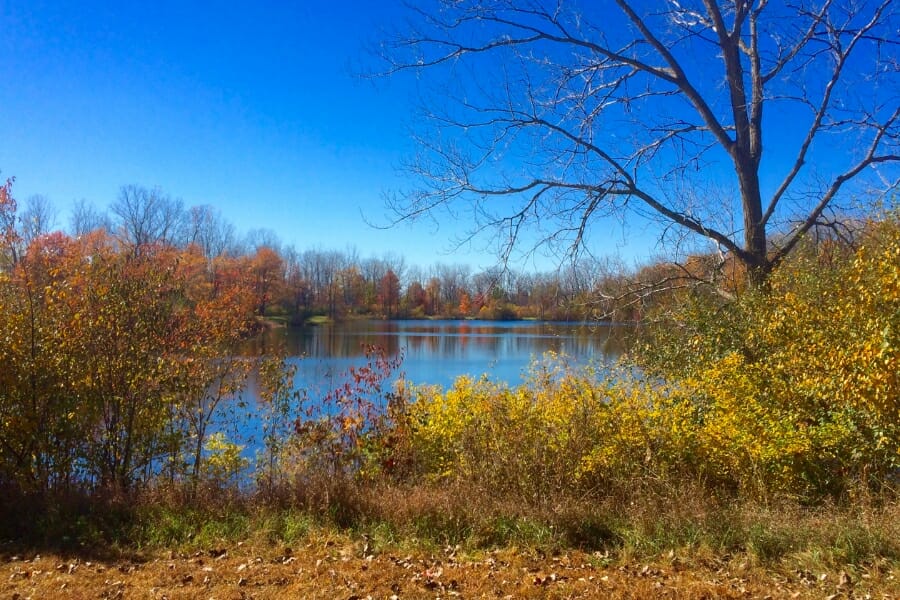
Fort Wayne is a city with a rich geological history and is a promising place for rockhounds to explore. It offers a diverse geological landscape that can yield some exciting discoveries, including agates.
Geographically, Fort Wayne is situated in the Maumee Valley, a region with gently rolling hills and fertile plains. The city itself is located near the convergence of the St. Joseph and St. Marys Rivers, which join to form the Maumee River.
The surrounding area of Fort Wayne features a mix of urban development and natural landscapes, making it an intriguing place for geological exploration. Among its variety of features are riverbanks, creek beds, and exposed rock outcrops.
Thanks to its location along major highways and well-maintained roadways, getting to Fort Wayne is convenient. It’s easily accessible by car and is served by an airport for those coming from farther away.
Where we found agates in Fort Wayne
If you want to find agates, search in the area farms and fields of Fort Wayne.
Other Great Places To Find Agates in Indiana

Additional areas you can find agates
In case you’re having a hard time locating agates, make sure to pay close attention to the following areas where they usually hide:
Rivers and Riverbanks
Rivers and riverbanks are fantastic hunting grounds for agates, and Indiana is no exception. They constantly wear down and expose rocks. As they meander through landscapes, they churn up and transport agate-containing rocks downstream, ultimately depositing them along their banks.
Indiana’s rivers offer excellent opportunities for agate hunting. The geological diversity and the constant water flow create ideal conditions for agate deposition.
Streams and Creeks
Streams and creeks are also fantastic spots for agate hunting in Indiana. These waterways naturally erode rocks and carry them downstream, exposing agate-containing rocks in their beds.
When you explore the banks and gravel bars of streams and creeks, you’re likely to stumble upon agates, especially after periods of high water flow when new treasures are exposed.
Quarries
Quarries are excellent places for agate hunting as they often expose rocks deep below the Earth’s surface, where agates have the chance to form undisturbed over millions of years.
Indiana’s quarries, especially those in limestone-rich regions, are known for producing a variety of agates. As quarrying operations dig deeper, they can unearth agate-filled pockets and geodes. Exploring these quarries can lead to exciting agate discoveries.
Common Agate-Hunting Questions
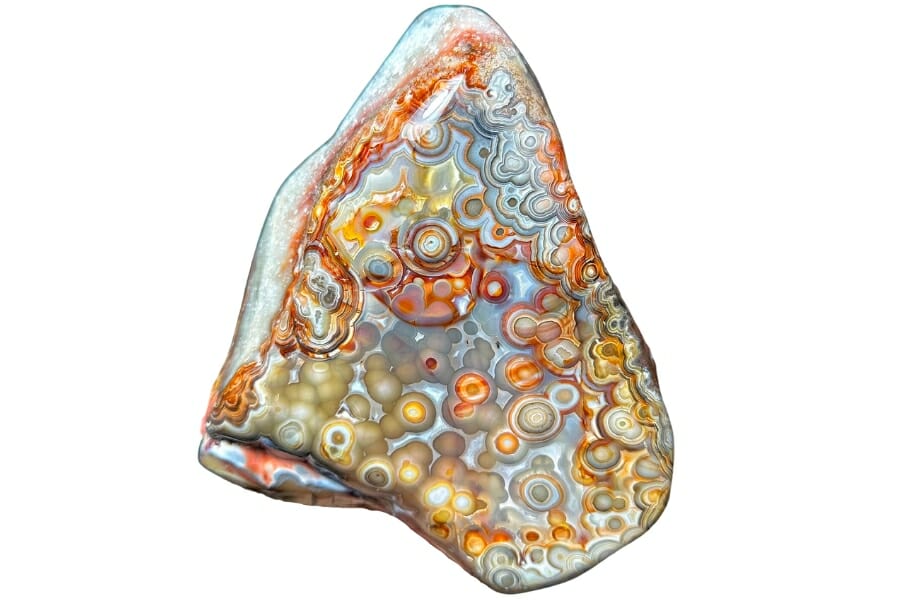
Before you start packing your bags for your agate-hunting journey here, allow us to answer the most common question when it comes to finding Indiana agates:
Is it illegal to collect agate in Indiana?
Collecting agates in Indiana is generally not illegal, provided you follow certain guidelines and respect local regulations.
However, it’s crucial to be aware that collecting on public lands, such as state parks, riverbanks, and other publicly accessible areas, is typically allowed as long as you adhere to any park or site-specific rules. Meanwhile, collecting on private property without permission is both illegal and considered trespassing.
Some natural areas, particularly those with unique ecological or geological features, have restrictions on collecting to preserve the environment. For more information, check with the Indiana Department of Natural Resources (DNR).
The Best Places To Buy Agates In Indiana
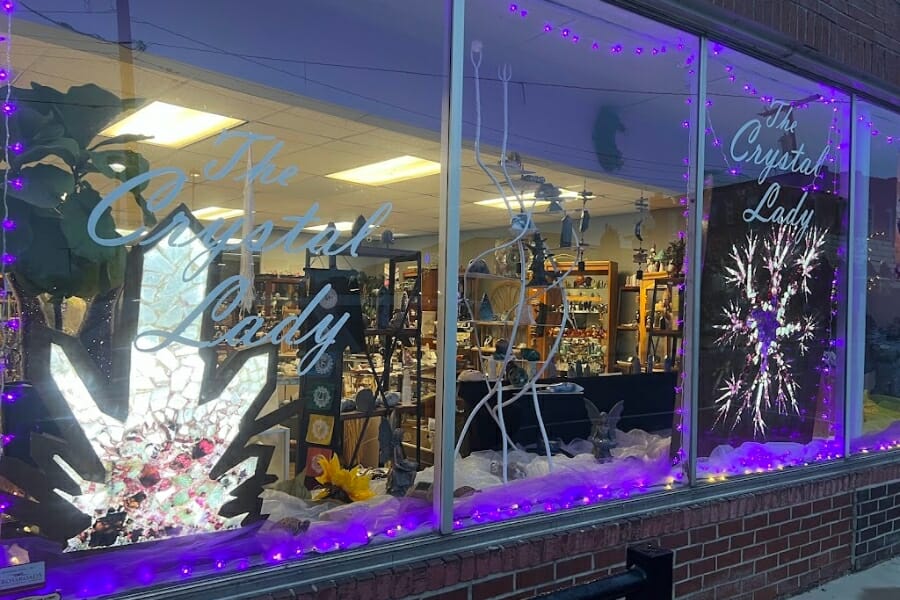
Another great way to observe and potentially take home an agate from Indiana is by visiting our trusted local rock and mineral shops. Below are some of them:
- All My Relations – 7218 Rockville Rd, Indianapolis, IN 46214
- Eric’s Rocks & Such – 610 Plaza Dr, Leavenworth, IN 47137
- Geodes and Gemstones – 300 Hwy 35 N, Knox, IN 46534
- Joy Rox Rock Shop – 4825 N Franklin Rd, Indianapolis, IN 46226
- Love Rocks Lapidary – 16624 Winchester Rd, Ossian, IN 46777
- Metamora’s Gem Mine and Luna’s Garden Gift Shop – 19055 Main St, Metamora, IN 47030
- The Crystal Lady – 192 W Joliet St B, Crown Point, IN 46307
If you have any recommendations for our list please leave a comment below!

